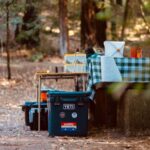There’s nothing quite like the call of the wild—a note of adventure, a promise of serenity. But part of this call involves understanding how to stay safe around the untamed beings that tread these remote lands. Whether you are an experienced camper or embarking on your first expedition, wildlife safety tips can be life-saving. This comprehensive guide brings you essential advice on staying safe around bears and other wildlife so your outdoor adventures remain thrilling and secure.
Understanding Bear Behavior and Identification
Bears are majestic but potentially dangerous animals. Knowing how to identify the different types of bears and understanding their behavior can significantly influence your safety.
Identifying Different Types of Bears
Firstly, it’s crucial to identify the type of bear you might encounter.
- Black Bears: These are the most common in North America. They range in color from black to various shades of brown. They have a straight facial profile and no shoulder hump.
- Brown Bears (Grizzly Bears): Recognizable by their prominent shoulder hump and concave facial profile, brown bears are more aggressive than black bears and primarily inhabit the western states.
- Polar Bears: Rare in the continental USA, polar bears are found in arctic regions. They are the largest and most aggressive, with white fur and elongated necks.
Bear Safety Rhymes and Their Meanings
Remembering bear safety rhymes and their meanings can be crucial:
- “If it’s black, fight back”: Black bears can often be scared away by making loud noises and appearing intimidating.
- “If it’s brown, lay down (play dead, cover your neck, try and lay belly down)”: Brown bears may attack if provoked, and playing dead can prevent further aggression.
- “If it’s white, say a prayer, good night”: Polar bears are highly aggressive and less likely to be deterred by humans. Immediate escape or defense is necessary.
Practical Safety Tips
Facing a bear encounter can be daunting, but following these practical safety tips can help you manage it effectively.
General Bear Encounter Tips
Proper preparation and precautions can significantly reduce the likelihood of a bear encounter:
- Food Storage: The best bear-proof food storage methods include using bear canisters and Ursacks. Store food away from sleeping areas and, if necessary, hang food in a tree.
- Clean Campsite: Always keep your campsite clean and practice proper disposal of campsite waste. Pack out all litter, and do not leave food scraps behind.
- Bear Spray: Carry bear spray at all times and know the techniques for using bear spray. Its effectiveness largely depends on your ability to deploy it quickly and accurately.
Dealing with Encounters
If you do encounter a bear, your response can determine the outcome:
- Stay Calm: Panicking can provoke the animal.
- Make Yourself Look Bigger: Raise your arms, stand tall, and make loud noises, especially when confronting black bears.
- Never Run: Running can trigger a bear’s predatory instincts. Instead, gather your group and back away slowly.
Other Wildlife Considerations
Bears aren’t the only wildlife you might encounter while camping. Here are some tips for dealing with other animals.
Dealing with Smaller Predators
- Foxes, coyotes, and raccoons: Ensure all food and trash are secured, avoid feeding them, and maintain a safe distance.
Handling Deer and Other Herbivores
- Deer: While typically not dangerous, maintain a respectful distance and never feed them. Be particularly cautious during mating season, as deer can become aggressive.
Encountering Snakes and Reptiles
Snakes might not seem as menacing as bears, but they can pose serious risks:
- Identify venomous snakes in your camping area.
- Stay on marked trails and avoid tall grass or rocky areas where snakes may hide.
- Treat all snake bites seriously and seek immediate medical attention.
Emergency Preparedness
The unpredictability of nature necessitates being ready for emergencies:
Always have a first aid kit available and be knowledgeable in basic first aid procedures for injuries, including wildlife encounters. Consider taking wilderness survival courses for in-depth preparedness. In the unfortunate event of a bear attack or serious wildlife injury, knowing what to do can be lifesaving. Ensuring everyone in your group also knows these basics can be crucial.
Conclusion
The beauty of the wilderness comes with its challenges, and ensuring your safety around wildlife, particularly bears, is paramount. By understanding different types of bears and their behaviors, employing the best bear-proof food storage methods, maintaining a clean campsite, and knowing techniques for using bear spray, you can significantly reduce risks. Remember that proper disposal of campsite waste is not just about cleanliness—it’s a crucial action to attract or deter bears and other wildlife. Ultimately, respecting wildlife and preserving their habitats enhances the safety and enjoyment of your outdoor adventures.
We invite you to share your own wildlife encounter stories and tips in the comments. Subscribe to our blog for more outdoor safety tips and wilderness adventure guides. Happy and safe camping!




